The week at a glance
- Crested Lark in Kent
- Collared Flycatcher in Dorset
- Wood Duck still on Shetland
- Zitting Cisticolas still on Guernsey
- Record-breaking flock of Whiskered Terns in Derbyshire
- Crested Lark in Kent
- Collared Flycatcher in Dorset
- Wood Duck still on Shetland
- Zitting Cisticolas still on Guernsey
- Record-breaking flock of Whiskered Terns in Derbyshire
Given the time of year, the burst of activity that occurred during the middle of the review period was welcome, but to be expected. Many of the species involved were unexceptional, but the summery weather did manage to produce one of those "not-to-be-repeated" historical birding moments. Not some outrageous first, just a group of outrageous record-breakers that got many birders buzzing. Then, catching many unawares, as the week came to an end a couple of high-quality rarities (one a genuine mega) ensured that the buzz continued long and loud as May loomed large.
So, just as the sun began to set on another week's review, the spring's highest-quality rarity so far, a Crested Lark, popped up at Dungeness (Kent) on the evening of 29th. Taking almost everyone by surprise, this is a species of genuine "blocker" status and many a twitcher will have had a sleepless night ahead of their jaunts to the south coast. It was back in October 1996 that birders last had the chance to add this almost dowdy mega to their lists (the fantastically showy autumn bird at Landguard in Suffolk). Despite the relative proximity of the species to the English coast (they really are still just "over there" on the French coast, easily seen from Kentish beaches on a good day) it has taken almost 13 years for another to make it over the English Channel. The Landguard bird was the first Crested Lark in over 14 years, since one was seen for two days on Bardsey Island in June 1982. Before that, it was September 1975 and Dungeness was again the chosen location. If it lingers (and it may have been heard a couple of days beforehand), the 2009 Dungeness bird is sure to draw a crowd, rather like the other obvious headline-maker this week, the first-summer male Collared Flycatcher found further along the south coast in a private garden at Southwell, Portland (Dorset) on the afternoon of 28th. Fortunately for the many people yet to see this classy little species, the bird obligingly popped up on 29th in an area that could be viewed by the general birding public. Once accepted this will be the first for Portland and Dorset too, and it will also become the earliest-ever Collared Flycatcher in Britain, beating the bird in Aberdeenshire in April 1999 by two days. The most recent twitchable bird on the mainland was the male at Church Norton in West Sussex in June 2002. All accepted birds since then have been on Shetland (birds reported in Devon and Orkney last year have yet to appear in print). Talking of Shetland, the drake Wood Duck remained (albeit a little intermittently) on Loch of Brow on 23rd and 25th. The odd insurance lister has ventured forth to the far north just in case, but let's hope it doesn't "do a Dorset Hooded Merganser" and stay forever and tarnish its credentials by failing any future bread-tests. No danger of Guernsey's two Zitting Cisticolas doing that; they remained at Port Soif until the middle of the week at least.

Crested Lark, Dungeness, Kent (Photo: David H Hatton)

Collared Flycatcher, Portland, Dorset (Photo: Brian Irvine)
Crested Lark and Collared Flycatcher: superb rarities the pair of them, but there was one other occurrence this week that grabbed almost as many headlines. It all started happening during the middle of the afternoon on 24th. A report came through of a flock of eight Whiskered Terns at Willington GPs (Derbyshire). A flock of eight Whiskered Terns is remarkable (double the size of the largest previous British group) but after half an hour the number had climbed to 10 birds and within the time it takes to play a footy match, the flock had increased to an astonishing 11 birds. Imagine that — 11 Whiskered Terns! Quite what the finder must have been thinking as the scene unfolded is anyone's guess but the double-figure flock remained in place throughout the rest of the day until dusk. The following day eight birds were left and they stayed on site until mid-morning of 26th, with three birds present until mid-evening, at which time they too left the site. Needless to say, some of the splinter groups were relocated elsewhere on 26th: five birds arrived at Croxall Lakes (Staffordshire) and one was at Long Eaton (Derbyshire), while in the northeast two birds appeared at Saltholme Pools (Cleveland). A potential first Whiskered Tern for Northern Ireland was found at Quoile Pondage (Co. Down); this was a bird unrelated to the "Willington 11". Another individual that was separate again from the Derbyshire birds was found at Frampton-upon-Severn (Gloucestershire) on 25th. The bird left Frampton around midday (appearing briefly at nearby Saul Warth) before disappearing for good (although could this bird have then continued to Northern Ireland?). On 27th, the birds dispersed further still, with two, three or four arriving at Rutland Water (Leicestershire) and one also popped up at Paxton Pits (Cambridgeshire). By 28th, one had relocated back to Willington and the bird at Paxton was still present. Before this incredible event, Derbyshire had only one previous record of Whiskered Tern on the record books, way, way back in the autumn of 1883; and the previous record flock size was four, a group seen in South Yorkshire in 2004 followed the year after by another quartet in Cheshire and Staffordshire.

Whiskered Tern, Willington GPs, Derbyshire (Photo: Jim Almond)
On the Outer Hebrides, at Port Nis on Lewis, an adult White-billed Diver was seen again on 25th–29th, while another was seen on Shetland, off the north side of Mousa, on 26th. In Highland, the long-staying White-billed Diver was seen again at Little Loch Broom on 28th. Two single Long-tailed Skuas were seen on 25th, one from Dungeness (Kent), the other off Langness (Isle of Man). At least 70 Pomarine Skuas were seen this week (from ten counties, mostly on the south coast). The six seen together off Kilnsea and Spurn (East Yorkshire) on 25th presented a rare sight indeed on the east coast at this time of year. More typical for the spring were the 12 that flew past St. Margaret's at Cliffe (Kent), also on 25th (with five there on 28th). Seven Pomarine Skuas were seen off Portland Bill (Dorset) on 27th. An unseasonable (winter-plumaged) Grey Phalarope was seen off Speeton (North Yorkshire) on 29th.
Odd single Cattle Egrets were present at a couple of sites in Cornwall, Devon and County Cork this week and two birds appeared at Plex Moss (Lancashire) on 23rd, remaining to 26th at least. Eight Cattle Egrets were by the Tourig River, Rincrew (Co. Waterford) on 28th. The long-staying Great White Egret was at Gilmourton (Clyde) for much of the week and another bird that seems to have been around a while is the one that popped up again on the Somerset Levels at the start of the week. Another frequent visitor to the review is the Great White Egret in Suffolk, and it was seen again this week at North Warren on 25th. New birds reported on the same date were at Cramlington (Northumberland) and Dolydd Hafren (Powys), the latter bird having been around for almost a week before this. On 26th, a Great White Egret flew over Burgh Castle (Norfolk) and on 29th a Great White Egret was found at Brow Marsh (Shetland) with another reported at Elmley Marshes (Kent). At least a dozen Spoonbills were seen during the week, including singles still at Loch of Strathbeg (Aberdeenshire) and Inner Marsh Farm (Cheshire). Two birds were at Hickling Broad (Norfolk) on 25th, with two more at Exminster Marshes (Devon) the previous day.
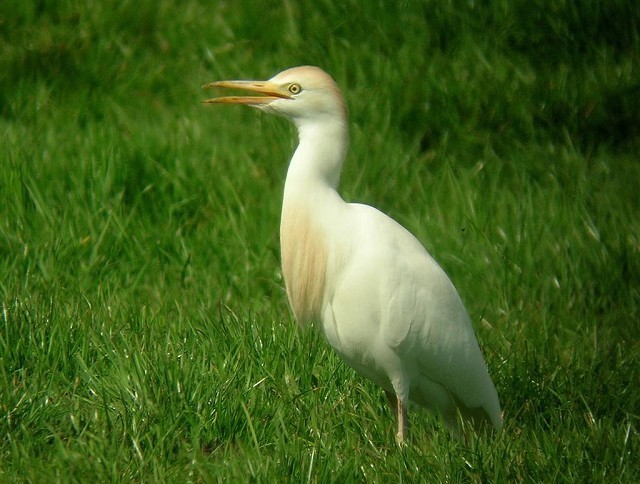
Cattle Egret, Plex Moss, Lancashire (Photo: Gavin Thomas)

Great White Egret, Arcot Ponds, Northumberland (Photo: Adam Williams)
In Norfolk, two Common Cranes were seen near Heacham on 24th while two more were seen the same day at Wood Lane NR (Shropshire) and Ambergate (Derbyshire). These two then appeared at Drayton Bassett Pits (Staffordshire) on 27th and Earls Barton (Northamptonshire) on 28th. Single birds this week were at Lakenheath Fen (Suffolk) and Burnham Overy (Norfolk) with another reported near Portsmouth (Hampshire) on 27th; on 28th, three Cranes were seen over Thorganby Ings (North Yorkshire). White Storks (some presumably of dubious origin) were seen in Forth, Northumberland, South Yorkshire, Buckinghamshire, Hertfordshire, Essex, London (seen over Canning Town and Hornchurch on 28th) and Gwent. The first-summer Purple Heron at Walthamstow Reservoirs (London) on 23rd was anything but dubious. The bird remained until the early morning of 25th and was then seen at the Middlesex Filter Beds and Cross Ness to 27th. On the evening of 26th, another (?) first-summer Purple Heron was seen from Staines Reservoir (Surrey) heading out across Heathrow Airport. The third first-summer Purple Heron of the week flew steadily eastwards over Cley Marshes (Norfolk) on 27th, flying past Salthouse and Kelling Quags before being lost to view over Weybourne Camp. Also in Norfolk, on 28th, a Purple Heron was seen at Bradfield Hall Farm near North Walsham.

Common Crane, Earls Barton GPs, Northamptonshire (Photo: John Betts)

Purple Heron, Walthamstow Reservoirs, Greater London (Photo: Roy Woodward)
The two Snow Geese (one white, one blue) were still present at Loch of Strathbeg to 28th. Earlier in the week, three white-morph birds were seen flying north over Druridge Pools (Northumberland) on 25th — where did they come from? The same could be said for the Snow Goose at Silloth (Cumbria) on 29th. A Black Brant was at Frampton Marsh (Lincolnshire) on 24th.
The only Lesser Scaup noted this week was the first-winter drake in Cardiff Bay (Glamorgan), present to 28th at least. A female Ring-necked Duck remained at Swineham GPs (Dorset) while drakes included singles in Highland, at Loch Calder and Loch Croispol, Balnakeil, and further single males were still on Loch of Tingwall (Shetland) and Loch an Eilein (Tiree). The drake Ferruginous Duck was at Chew Valley Lake (Somerset) on 23rd–24th before relocating to Wimbleball Lake on 26th–28th. A female Ferruginous Duck spent 23rd at Stewartby (Bedfordshire) with another female at Livermere Lake (Suffolk) on 28th.
These days barely a soul gets wildly excited about the discovery of a drake Green-winged Teal, but this week was a little different. The finding of one on Fair Isle on 25th was another little bit of history for the island: a first no less — following hot on the heels of five last year, including the Citril Finch of course — and (until the mooted "re-lump" comes along) the tally for this remarkable birding hotspot rises to 373. Other new birds this week were seen at Quoile Pondage (Co. Down), Cley Marshes (Norfolk), West Freugh Airfield (Dumfries & Galloway), Loch of Strathbeg (Aberdeenshire) and Loch Stiapavat (Lewis), while others remained in Leicestershire, Cheshire, Argyll and County Clare. A drake Blue-winged Teal was reported just south of Kirkwall (Orkney) on 27th, but there was no sign in subsequent searches.
A drake Surf Scoter was near Finstown (Orkney) on 24th and a female was in Dunnet Bay (Highland) from 25th (and was present for a few days prior to this). The Hooded Merganser was at Radipole Lake (Dorset) to 29th.
A released White-tailed Eagle remained in Perth & Kinross in the early part of the week, while late Rough-legged Buzzards were seen in Suffolk at Weston on 25th and Thornham Magna on 27th, with another at Melvich (Highland) on 29th. A Black Kite was at Sandwick (Shetland) on 27th, the second of the decade for the island group (and only the fourth ever). The bird remained to 29th, when it was seen at Channerwick. An adult male Red-footed Falcon was reported on Kelling Heath (Norfolk) on 24th and a female was seen on Portland (Dorset) the following day. Another female Red-footed Falcon was seen near Cockerington (Lincolnshire) on 27th. On Orkney, a male Snowy Owl was found near Holm on 28th, and another bird turned up at St. Saviour's Reservoir on Guernsey, a different bird to the long-stayer on Lihou island.

Black Kite, Channerwick, Mainland, Shetland (Photo: Steve Minton)
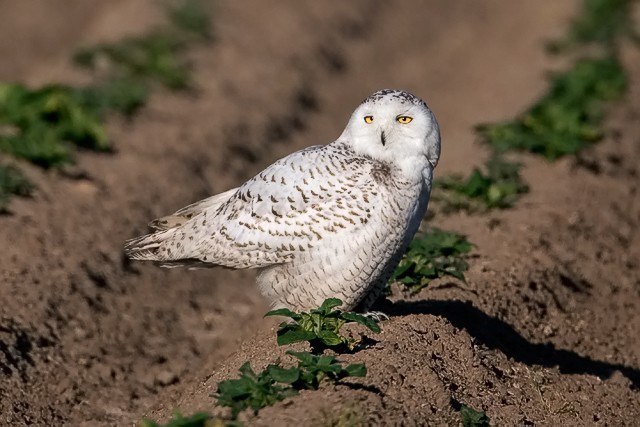
Snowy Owl, St. Saviour's Reservoir, Guernsey (Photo: Paul Hillion)
A Black-winged Stilt was seen at Maxey GPs (Cambridgeshire) on 25th (the first in the county since one in late April 2005) and this may have been the bird seen earlier in the day at Deeping Lakes (Lincolnshire). A male Kentish Plover paid a brief visit to Minsmere (Suffolk) on 26th and, also in Suffolk on the same day, a male Kentish Plover was seen at Orford Ness. The two Pectoral Sandpipers at Cossington Meadows (Leicestershire) stayed together to 24th, with one bird remaining to 26th at least. Further singles were seen at Walmsley Sanctuary (Cornwall) and Loch of Strathbeg (Aberdeenshire), both on 26th. The Lesser Yellowlegs was still on the Blackwater Estuary (Essex) on 23rd and was followed by singles at Pegwell Bay (Kent) on 25th, with the same bird reappearing at Sandwich Bay (Kent) on 26th, and another at Loch Gruinart (Argyll) the same day. The latter site was also hosting a Long-billed Dowitcher on 26th, with the bird in Dundalk (Co. Louth) still present on 25th.

Black-winged Stilt, Maxey GPs, Cambridgeshire (Photo: Jamie Wells)

Lesser Yellowlegs, Maldon, Essex (Photo: Martin Back)
A group of eight Dotterel was seen out on Wallasea Island (Essex) on 25th. Two were seen briefly at Happisburgh (Norfolk) on 26th and three birds were at Axletree Edge (Greater Manchester) on 27th–28th. Singles were also seen in Lincolnshire, Hertfordshire and Carmarthenshire. On Scilly, the Temminck's Stint remained on St. Mary's from 23rd–26th. This is still a rare bird for island listers: the last record was in September 2001 (two birds on Tresco) and there are only three other spring records before this one. Another Temminck's Stint was at Walmsley Sanctuary (Cornwall) on 29th, and one was reported briefly at Cley Marshes on 28th.

Dotterel, Axletree Edge, Greater Manchester (Photo: Dean Eades)
The only Caspian Gull of the week was a second-summer reported at Newbiggin-by-the-Sea (Northumberland) on 24th. This week saw a slight hike in numbers of Iceland Gulls: up from 45 to at least 65 birds, including 10 still at Killybegs (Co. Donegal) on 23rd. A juvenile Kumlien's Gull was seen at the southern end of mainland Shetland on 23rd–26th with another Shetland juvenile on Whalsay on 28th. The third juvenile of the week was at Shawbost (Lewis) on 26th and it or another juvenile was seen at Loch Barvas, also on Lewis, on 29th. An adult Kumlien's Gull was on Loch Ryan (Dumfries & Galloway) on 28th.The second-winter "Kumlien's Gull" was seen again at Blackborough End (Norfolk) on 25th, but photos of the bird show it to be closer in appearance to a Herring Gull (albeit an oddly marked one, or possibly some sort of Herring Gull hybrid); it certainly isn't the county's first Kumlien's Gull. Only around 20 Glaucous Gulls were seen during the week but did include one with four Orcas off the Butt of Lewis (Outer Hebrides) on 26th while, also on the Hebrides, four birds were seen at Rubha Ardvule, South Uist on 27th. An adult Ring-billed Gull was seen at Ballyheige Bay (Co. Kerry) on 25th and the second-winter was still at Lamby Lake (Glamorgan) on 28th. In Cambridgeshire, a White-winged Black Tern was reported at Earith GPs on 25th.
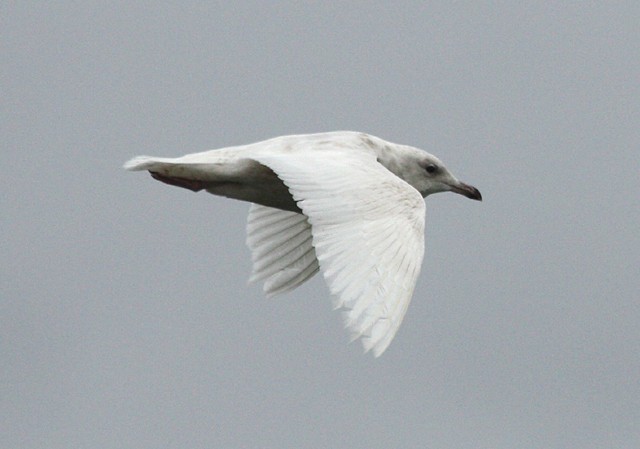
Iceland Gull, Anstruther, Fife (Photo: Willie McBay)

Kumlien's Gull, Hamister, Whalsay, Shetland (Photo: Jason Atkinson)
It was a decent week this week for Red-rumped Swallows, with up to 14 birds reported. The first of the week flew south over Horsey Gap (Norfolk) on 24th and was followed by another in Norfolk, at Cley, on 25th. On 26th singles were seen at St Margaret's at Cliffe (Kent), Filey Brigg (North Yorkshire), Atwick and Flamborough Head (both East Yorkshire), while two birds were seen over Spurn. The following day, Red-rumped Swallows were seen at Far Pasture (Co. Durham) and Swine Moor (East Yorkshire) and on 28th two birds were seen over Hornsea Mere (East Yorkshire). Also on 28th, a county-first Red-rumped Swallow was seen at Kilmany (Fife), remaining to 29th, when another was seen at Minsmere.

Red-rumped Swallow, Kilmany, Fife (Photo: Willie McBay)
Just three Hoopoes were noted this week. One was at Windmill Farm NR (Cornwall) on 23rd and another was reported briefly in a garden near Shaftesbury (Dorset) the same day. On 26th, the third was seen at Blow's Down (Bedfordshire). An Alpine Swift spent five minutes over Meare Heath (Somerset) on 24th and another brief flyover was witnessed at the Walmsley Sanctuary (Cornwall) on 29th. Single Wrynecks at Donna Nook (Lincolnshire) and North Ronaldsay (Orkney) on 23rd were the first of up to 13 birds this week. On 25th one was seen in the dunes at Burnham Overy (Norfolk); on 26th one was seen in Warsash (Hampshire); and on 27th a Wryneck was found at Westleton Heath (Suffolk). Four birds appeared on 28th, two close together in east Norfolk (at Waxham and Winterton) with singles at Buckfastleigh (Devon) and North Ronaldsay (Orkney). On 29th up to three Wrynecks were found at Spurn (East Yorkshire) and another was seen at Glynde (East Sussex).
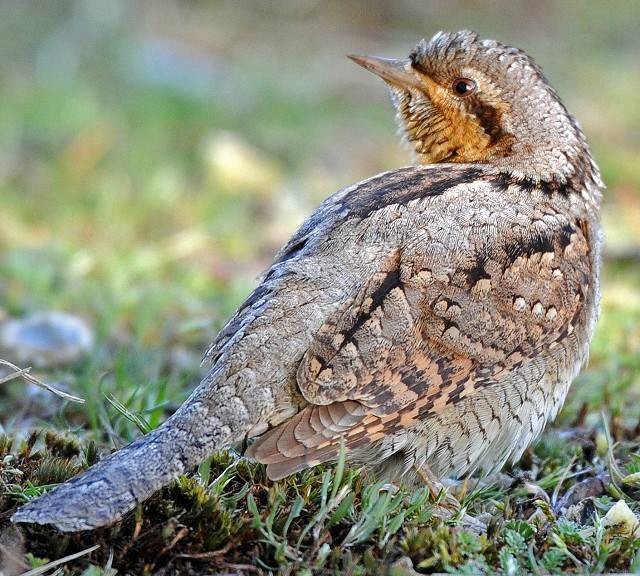
Wryneck, Westleton Heath, Suffolk (Photo: Jon Evans)
A handsome first-summer male Black-headed Wagtail was something of a surprise during the late afternoon of 25th at Titchwell (Norfolk). The bird showed well in a ploughed field near the reserve until dusk but those hoping for a repeat performance the next morning were to be disappointed. However, there was another one up for grabs! Another male Black-headed Wagtail was found on Holy Island (Northumberland) on 26th and was even more dapper and better marked than the Norfolk bird. The spring's first Red-throated Pipit was found out on Brownsman Island in the Farnes (Northumberland) on 28th and on Anglesey a female Bluethroat spent 24th–25th at Cemlyn Bay.

Black-headed Wagtail, Titchwell RSPB, Norfolk (Photo: Steve Seal)

Bluethroat, Cemlyn Bay, Anglesey (Photo: Alan Burfitt)
In Ireland, the male Woodchat Shrike seen last week near Ballydwan (Co. Waterford) was relocated on 25th and was still present on 28th. Up to five other Woodchats were seen this week: on Scilly, one was on St. Martin's from 23rd–26th and another (?) appeared on Bryher on 28th. A male Woodchat was reported from a garden in Welwyn Garden City (Hertfordshire) on 24th, and on 27th a first-summer female was found in Plymouth (Devon) where she remained until 29th. Also on 29th, a male Woodchat Shrike was seen in a site with no general access near Yeovil (Somerset). A single Great Grey Shrike was still at Speech House (Gloucestershire) to 23rd while a Red-backed Shrike was reported at Reculver (Kent) on 25th. The same day saw a male Golden Oriole burst into song in Ipswich (with a mellow, fluty "Keano" presumably). By the end of the review period two Golden Orioles were back at the traditional breeding spot at Lakenheath Fen (Suffolk). Some 400 Waxwings could still be found countrywide this week, including 92+ in Sheffield on 29th.

Woodchat Shrike, Plymouth, Devon (Photo: Chris Buckland)
The male (presumed) Eastern Subalpine Warbler (S. c. albistriata) was still in the scrubby garden at Scatness (Shetland) on 23rd and again on 25th, occasionally showing wonderfully well. A second male Subalpine Warbler was found at the Newport Wetlands/Uskmouth RSPB reserve (Gwent) on 26th and was still present to 28th (and represented a county first for good measure). It too looked rather more like an Eastern than a Western (but what about Moltoni's?).
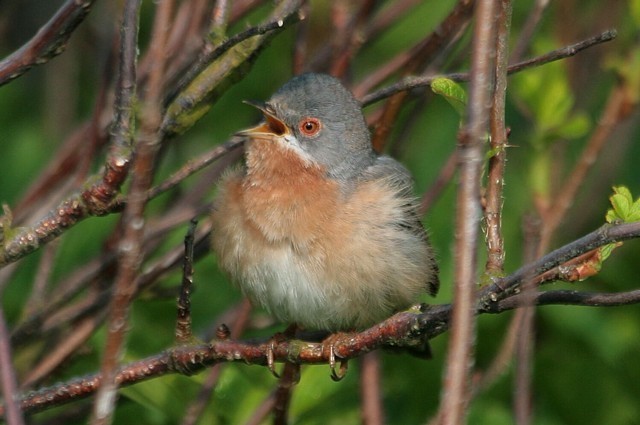
Subalpine Warbler, Scatness, Mainland, Shetland (Photo: anon)

Subalpine Warbler, Newport Wetlands, Gwent (Photo: Nathan Casburn)
This week's fly-over Serins were seen at Margate (Kent) on 23rd, Landguard NR and Bawdsey (Suffolk) on 26th. Another was seen briefly at Portland (Dorset) on 28th. In East Yorkshire, the Little Bunting remained at Flamborough Head to 23rd and reappeared on 25th–26th. The second Little Bunting of the week was seen at Margate on 23rd, the bird singing for five early-morning minutes before heading off west.
Photo of the Week

Gannet, Bempton Cliffs RSPB, East Yorkshire (Photo:
David Cookson)
Bempton Cliffs RSPB reserve in East Yorkshire has become a 'honeypot' site for bird photographers, offering guaranteed views of a variety of seabirds at close range. It's no surprise, then, that we receive dozens of seabird images each week from this location during the breeding season. This presents a challenge to bird photographers to go beyond capturing a textbook shot to producing an image that stands out from the crowd. Creating a unique view of such well-photographed species takes considerable creativity and skill. Top bird photographer David Cookson takes such challenges in his stride, on this occasion creating a very different take on a Gannet flight shot. David's bold composition features an unusual combination of a head-on flight shot with a head-turn showing the striking facial features of this species. Sharp focus, accurate exposure and a tight crop round off a stunning image.

Sedge Warbler, Barton-upon-Humber Pits, Lincolnshire (Photo:
Graham Catley)

Curlew, East Walton, Norfolk (Photo:
Stephen Durrant)

Grasshopper Warbler, undisclosed site, Cheshire (Photo:
Richard Steel)
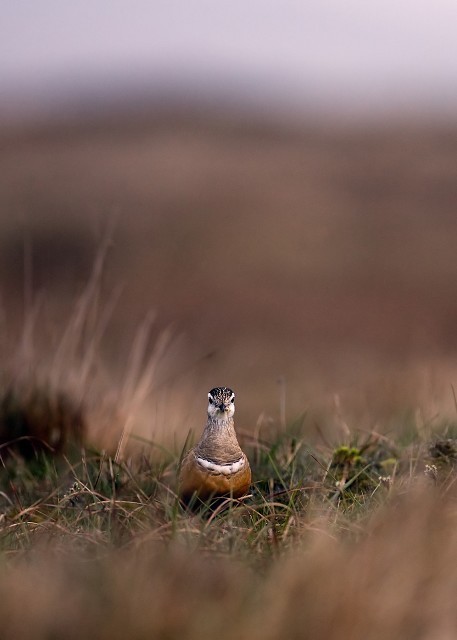
Dotterel, Axletree Edge, Greater Manchester (Photo:
Marcus Conway)
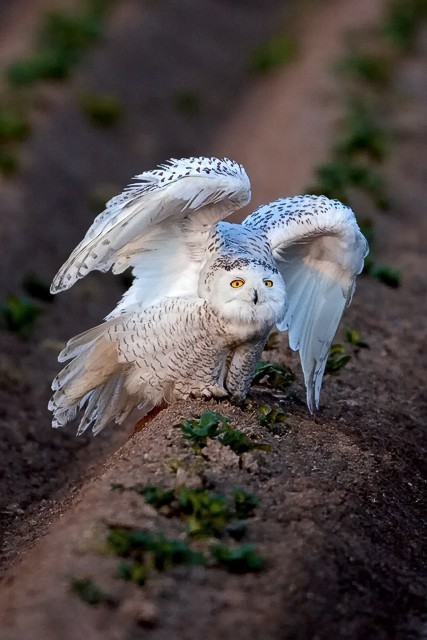
Snowy Owl, St. Saviour's Reservoir, Guernsey (Photo:
Paul Hillion)

Razorbill, Bempton Cliffs RSPB, East Yorkshire (Photo:
Nigel Pye)

Little Grebe, undisclosed site, Derbyshire (Photo:
Robert Askew)

Great Crested Grebe, Mere Sands Wood LWT, Lancashire (Photo:
Tom Charles)
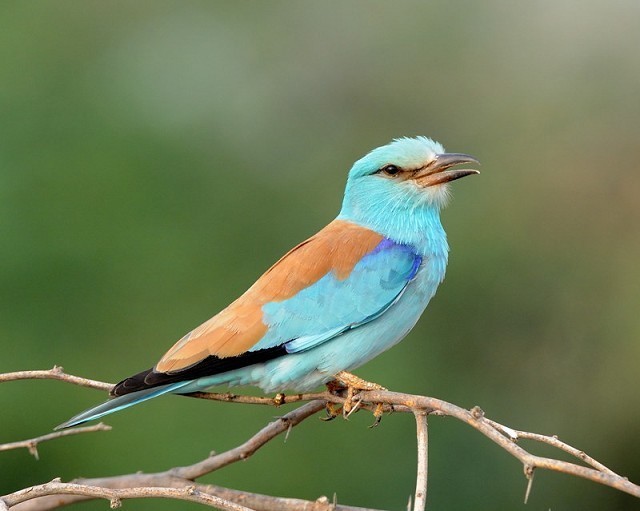
European Roller, Saudi Arabia (Photo:
Adrian Drummond-Hill)

Swallow, Minsmere RSPB, Suffolk (Photo:
Jon Evans)
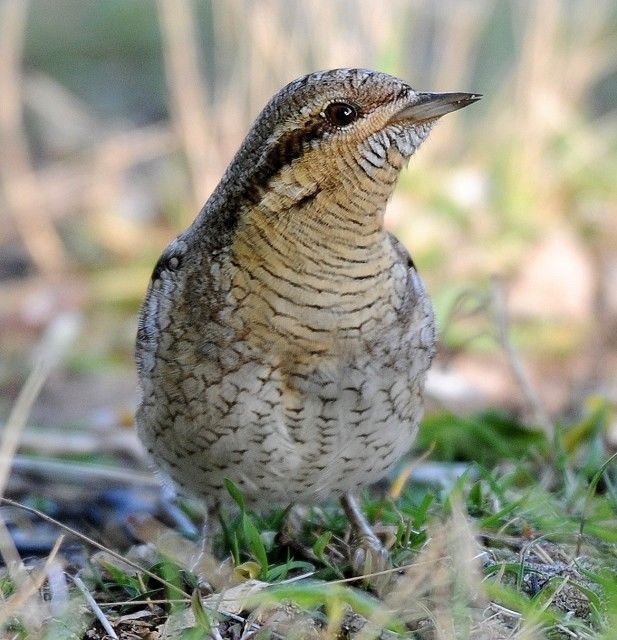
Wryneck, Westleton Heath, Suffolk (Photo:
Jon Evans)

Tufted Duck, Summer Leys LNR, Northamptonshire (Photo:
Richard Bedford)

Lesser Spotted Woodpecker, undisclosed site, West Yorkshire (Photo:
Sean Gray)
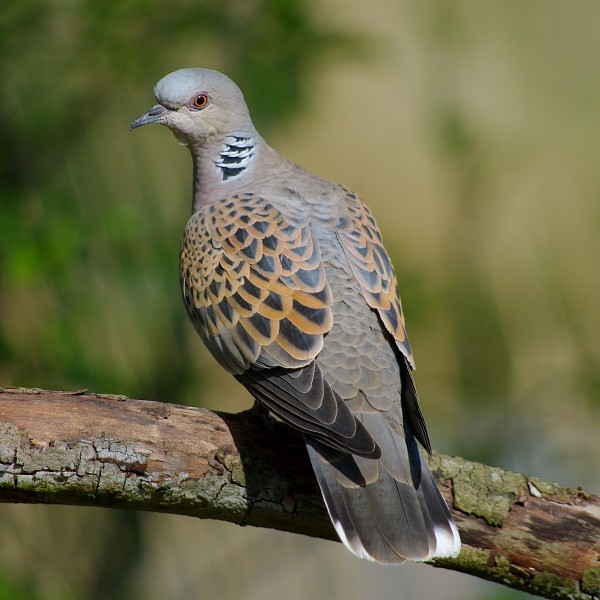
Turtle Dove, Tetney Lock (village), Lincolnshire (Photo:
Dave Bradbeer)

Pied Flycatcher, Llandrindod Wells, Powys (Photo:
Kev Joynes)

